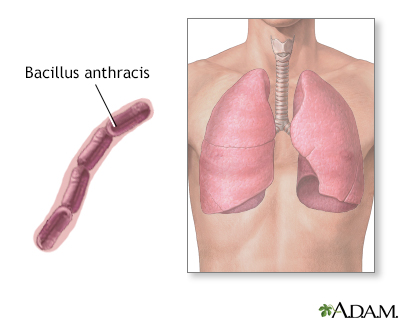Anthrax blood test
Anthrax serology test; Antibody test for anthrax; Serologic test for B. anthracis
The anthrax blood test is used to measure substances (proteins) called antibodies, which are produced by the body in reaction to the bacteria that cause anthrax.
Images


I Would Like to Learn About:
How the Test is Performed
How to Prepare for the Test
There is no special preparation.
How the Test will Feel
When the needle is inserted to draw blood, some people feel moderate pain. Others feel only a prick or stinging. Afterward, there may be some throbbing or slight bruising. This soon goes away.
Why the Test is Performed
This test may be performed when the health care provider suspects you have anthrax infection. The bacteria that cause anthrax is called Bacillus anthracis.
Normal Results
A normal result means no antibodies to the anthrax bacteria were seen in your blood sample. However, during the early stages of infection, your body may only produce a few antibodies, which the blood test may miss. The test may need to be repeated in 10 days to 2 weeks.
Normal value ranges may vary slightly among different laboratories. Some labs use different measurements or test different samples. Talk to your provider about the meaning of your specific test results.
What Abnormal Results Mean
An abnormal result means antibodies to the bacteria have been detected and you may have anthrax disease. But some people come in contact with the bacteria and do not develop the disease.
To determine if you have a current infection, your provider will look for an increase in the antibody count after a few weeks as well as your symptoms and physical exam findings.
Risks
There is little risk involved with having your blood taken. Veins and arteries vary in size from one person to another and from one side of the body to the other. Taking blood from some people may be more difficult than from others.
Other risks associated with having blood drawn are slight, but may include:
- Excessive bleeding
- Fainting or feeling lightheaded
- Multiple punctures to locate veins
- Hematoma (blood accumulating under the skin)
- Infection (a slight risk any time the skin is broken)
Considerations
The best test for diagnosing anthrax is a culture of affected tissue or blood.
Related Information
AntibodyAnthrax
References
Martin GJ, Friedlander AM. Bacillus anthracis (anthrax). In: Bennett JE, Dolin R, Blaser MJ, eds. Mandell, Douglas, and Bennett's Principles and Practice of Infectious Diseases. 9th ed. Philadelphia, PA: Elsevier; 2020:chap 207.
Wojewoda CM, Stempak LM. Medical bacteriology. In: McPherson RA, Pincus MR, eds. Henry's Clinical Diagnosis and Management by Laboratory Methods. 24th ed. Philadelphia, PA: Elsevier; 2022:chap 57.
BACK TO TOPReview Date: 8/26/2023
Reviewed By: Jatin M. Vyas, MD, PhD, Associate Professor in Medicine, Harvard Medical School; Associate in Medicine, Division of Infectious Disease, Department of Medicine, Massachusetts General Hospital, Boston, MA. Also reviewed by David C. Dugdale, MD, Medical Director, Brenda Conaway, Editorial Director, and the A.D.A.M. Editorial team.

Health Content Provider
06/01/2025
|
A.D.A.M., Inc. is accredited by URAC, for Health Content Provider (www.urac.org). URAC's accreditation program is an independent audit to verify that A.D.A.M. follows rigorous standards of quality and accountability. A.D.A.M. is among the first to achieve this important distinction for online health information and services. Learn more about A.D.A.M.'s editorial policy, editorial process and privacy policy. A.D.A.M. is also a founding member of Hi-Ethics. This site complied with the HONcode standard for trustworthy health information from 1995 to 2022, after which HON (Health On the Net, a not-for-profit organization that promoted transparent and reliable health information online) was discontinued. |
The information provided herein should not be used during any medical emergency or for the diagnosis or treatment of any medical condition. A licensed medical professional should be consulted for diagnosis and treatment of any and all medical conditions. Links to other sites are provided for information only -- they do not constitute endorsements of those other sites. © 1997- 2024 A.D.A.M., a business unit of Ebix, Inc. Any duplication or distribution of the information contained herein is strictly prohibited.
